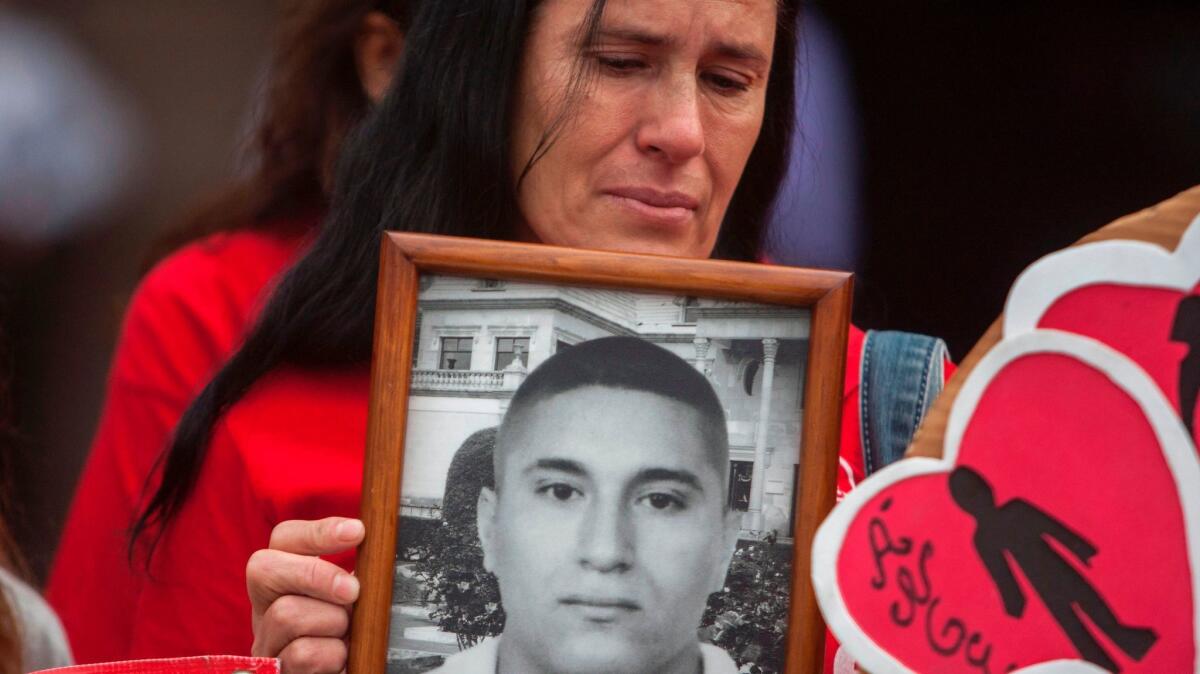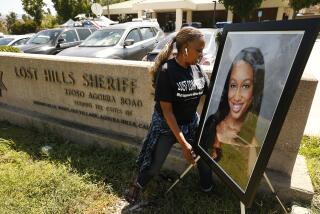A mom demanded justice for her daughter’s death in Mexico. On Mexican Mother’s Day, she was killed

- Share via
Reporting from Mexico City — She led a search for the “disappeared” in her home state of Tamaulipas, among the most violent in Mexico, after her daughter was kidnapped in 2012.
Her strenuous efforts in the face of official inaction helped nudge authorities in the embattled Gulf state along the Texas border to discover the partial remains of her daughter and arrest those allegedly involved in her death.
She sought protection from Mexican authorities this year after a prison break that she feared may have resulted in the escape of suspects in her daughter’s killing.
Now, Miriam Elizabeth Rodriguez has joined the growing roster of activists, journalists, clergy and others slain in a wave of killings in Mexico.
On Thursday, authorities confirmed that armed assailants opened fire late Wednesday on Rodriguez’s home in the city of San Fernando, fatally wounding the activist. She died on the way to the hospital.
She was killed on Mexico’s Mother’s Day, a major holiday in Mexico.

May 10 has also become a symbolically charged day when the mothers and other relatives of Mexico’s legions of missing publicly demand that authorities act on the cases of their vanished loved ones.
Protests to clarify the cases of Mexico’s estimated 30,000 or so disappeared — many abducted during the country’s more than decade-long war on drugs — took place throughout Mexico on Wednesday, the same day that Rodriguez was slain.
Rodriguez was part of a growing national movement of mothers and others who have sought out clandestine graves where their missing kin are believed to be buried. Some have taken picks and shovels to unearth remains from the secret graves.
Many contend that corrupt Mexican police and politicians acting in league with organized crime were implicated in the disappearances of their kin.
The killing of Rodriguez drew expressions of outrage from domestic and international activists, including from Amnesty International and the United Nations High Commissioner for Human Rights.
“The violent murder of Miriam Rodriguez should be investigated in [an] independent, impartial and exhaustive manner,” said Erika Guevera Rosas, Amnesty International’s Americas’ chief. “Steps should be taken to defend those who seek their [missing] loved ones.”
Federal and state authorities vowed to find her killers.
“I express my energetic condemnation for the cowardly murder of the activist Miriam Rodriguez,” Tamaulipas Gov. Francisco Javier Cabeza de Vaca said in a Twitter message. “The government of Tamaulipas will not permit that the death of Miriam Rordiguez will become one more statistic.”
Following her death, her activists colleagues charged that Rodriguez had requested police protection following the escape in March of inmates possibly linked to her daughter’s murder from a prison in Ciudad Victoria in Tamaulipas state.
“She herself expressed on various occasions in meetings with authorities that she was concerned that the kidnappers of her daughter had escaped ... and that this put her life at risk,” a fellow Tamaulipas activist, Guillermo Gutierrez, said in a radio interview. “We hope that with this lamentable event the state government put aside their authoritarianism and arrogance and punish the officials who should have given protection to our partner Miriam.”
But Luis Alberto Rodriguez Juarez, a state government spokesman in Tamaulipas, said officials had provided additional protection to Rodriguez in her home, with patrols passing by her home three times a day.
But the effort clearly did not deter her killers. Tamaulipas, which borders Texas’ Rio Grande Valley, is home turf for a number of criminal groups, including the ultra- violent Zetas cartel. The Zetas were implicated in the so-called “San Fernando massacre,” the mass murder in 2010 of 72 migrants — mostly U.S.-bound Central Americans — in the municipality of San Fernando, where Rodriguez was killed.
Heavily armed criminal organizations control drug trafficking, migrant smuggling and other illicit enterprises throughout Mexico.
Cecilia Sanchez of the Times Mexico City bureau contributed to this report.
twitter: @mcdneville
ALSO:
As Mexico combats fears about rising crime, a soldier is caught on tape carrying out an execution
Mexicans were afraid Trump would bring disaster. So far, his bark is worse than his bite
More to Read
Sign up for Essential California
The most important California stories and recommendations in your inbox every morning.
You may occasionally receive promotional content from the Los Angeles Times.










